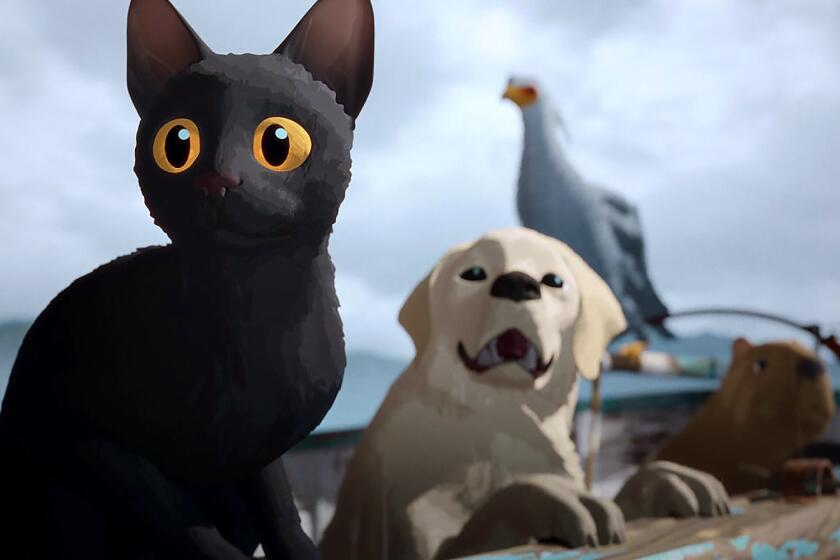HALLSTROM SHINES IN THE SWEDISH CINEMA : Rambunctious 12-Year-Old Star Makes ‘Dog’ as Endearing as a Warm Puppy
How has Swedish director Lasse Hallstrom remembered so precisely that knife edge between pain and delight that is childhood? In “My Life as a Dog” (Friday at the Music Hall) he has caught it all, in a sterling film whose style sits between the light moments of his compatriot, Ingmar Bergman, and the darker moments of Francois Truffaut’s childhood films. With freshness in such short supply that it’s nearly endangered, “My Life as a Dog” should be cherished.
The film’s 12-year-old hero, Ingemar, is frightened and unsettled when his thoughtful and beautiful photographer-mother contracts tuberculosis and is ordered to bed. But like most children, his concern has wild fluctuations. (He is played by Anton Glanzelius in an uncanny performance which is in turn exuberant and introspective. The portrayal won him the Swedish Oscar equivalent as Best Actor, while the film won Best Picture.)
Ingemar tries to do the things that made his mother laugh before; he quite consciously saves up funny stories and does pratfalls for her amusement. (You might think that just one look at her younger son, with his elfish triangular grin, his hair a warring series of cowlicks, his young fox’s eyes, would lift her spirits.) But with no father at hand, the clattering fights between Ingemar and his always-superior teen-age brother rattle their cheap railroad flat and push their mother into terrifying rages.
So, during this summer in the late 1950s, the boys are sent off to different relatives. Ingemar is also separated from the gray, scruffy mongrel Sickum, his closest friend. (Immune to doggy breath, Ingemar spends patient hours arranging Sickum’s mouth into a semblance of a smile.)
In a reverse of the expected, his young Uncle Gunnar (Tomas von Bromssen) and Aunt Ulla (Kicki Rundgren), who take in their rambunctious nephew, are wonderful and the tiny country town itself is idyllic--a Swedish version of Menzel’s sweet little Czech village, bursting with yeasty sex, affection and eccentricity in equal proportions.
Ingemar is also edging his way through preadolescence, and although sex is well down on his list of interests, it is passing like a perfumed breeze through the minds of many of his girl classmates. He seems to be safe with the exquisite Saga (Melinda Kinnaman) who, after all, is the best soccer player in town and a not-so-bad boxer either. Ingemar is among the select few who know that the lean, boyish Saga is a girl. Unfortunately, she can turn as jealous and possessive as his other bewildering female classmates, leaving Ingemar decidedly unsettled.
And the shadow of his mother’s illness never leaves his mind. While willing her to be better, he also tries to defend himself against his worst fears by putting her illness into a sort of cosmic perspective: It’s not as bad, he says thoughtfully, as the brave little dog Laika, sent up in Sputnik with only food enough for five months; she starved to death for science. “It’s important to have things like that to compare it to.”
He begins to collect other bizarre examples of life’s fatal inequities, the filler pieces without which no newspaper could exist (“Man Crossing Sports Arena Struck by Javelin”), and he uses them as a sort of dreadful solace.
It’s this dark undertone that keeps “My Life as a Dog” from becoming too sweet or too small. Hallstrom, who adapted the film (along with Reidar Jonsson, Brasse Brannstrom and Per Berglund) from a novel by Jonsson, has an uncanny knowledge of the spells and rituals with which children try to protect themselves. To see Ingemar clamping his hands on and off his ears to distort the sound of his mother’s fury is to be struck with an unmistakable jolt of memory.
Ingemar’s “dog life” comes from several sources, including his passion for Sickum. But it’s reinforced one evening when his uncle, playfully nuzzling his wife, goes down on all fours and begins barking at her. Ingemar delightedly joins him--here are adults given leave to behave foolishly--but when their bedroom door closes him out, he is pained and reminded of his abandonment again. The barking dog is all that’s left of Ingemar’s playful mood and he will revert to it, almost uncontrollably, again and again that summer--holding the world at bay with his snaps and snarls.
Yet it is that uncle, in all his faint foolishness, who will be Ingemar’s bridge to surviving that summer’s loss. A rumpled, curly headed, patient man who works at a glass-blowing factory, Uncle Gunnar is Hallstrom’s proof of the world’s simple, sturdy goodness, and “My Life as a Dog” is ours. (It is Times-rated Mature, allowing for some brief nudity.)
‘MY LIFE AS A DOG’ A Skouras Pictures release of a Svensk Finindustri Picture. Producer Waldemar Bergendahl. Director Lasse Hallstrom. Screenplay Hallstrom, Reidar Jonsson, Brasse Brannstrom, Per Berglund, based on the novel by Reidar Jonsson. Camera Jorgen Persson. Editors Christer Furubrand, Susanne Linnman. Sound Eddie Axberg, Goran Carmback. Music Bjorn Isfalt. Art director Lasse Westfelt. With Anton Glanzelius, Tomas von Bromssen, Anki Liden, Melinda Kinnaman, Kicki Rundgren, Ing-mari Carlsson.
Running time: 1 hour, 41 minutes.
Times-rated: Mature
More to Read
Only good movies
Get the Indie Focus newsletter, Mark Olsen's weekly guide to the world of cinema.
You may occasionally receive promotional content from the Los Angeles Times.










